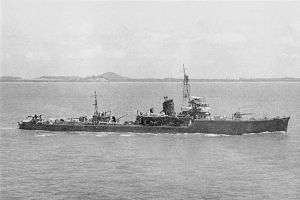W-7-class minesweeper (1938)
 No.7 on 23 September 1942 | |
| Class overview | |
|---|---|
| Name: | No.7-class minesweeper |
| Builders: | |
| Operators: |
|
| Preceded by: | No.13 class |
| Succeeded by: | No.19 class |
| Cost: | 2,230,823 JPY (in 1937) |
| Built: | 1937 – 1939 |
| In commission: | 1938 – 1946 |
| Planned: | 6 |
| Completed: | 6 |
| Lost: | 5 |
| Retired: | 1 |
| General characteristics | |
| Displacement: | 630 long tons (640 t) standard |
| Length: | 72.50 m (237 ft 10 in) overall |
| Beam: | 7.85 m (25 ft 9 in) |
| Draught: | 2.60 m (8 ft 6 in) |
| Propulsion: |
|
| Speed: | 20.0 knots (23.0 mph; 37.0 km/h) |
| Range: | 2,000 nmi (3,700 km) at 14 kn (16 mph; 26 km/h) |
| Complement: | 98 |
| Armament: |
|
The No.7-class minesweepers (第七号型掃海艇, Dai Nana Gō-gata Sōkaitei) were a class of minesweepers of the Imperial Japanese Navy (IJN), serving during the Second Sino-Japanese War and World War II. 6 vessels were built in 1937-39 under the Maru 3 Keikaku.
Background
- Project number I4. Improved model of the No.13-class. They were built to update timeworn No.7 class, No.9 class and No.11 class.[1] Kampon deleted minelayer facility from them, because IJN hoped they act in Yangtze River. And they added to 1 × 120 mm naval gun for engage with National Revolutionary Army. Therefore, No.7 class had the silhouette which resembled torpedo boat Chidori class and Ōtori class as well.
Ships in class
| Ship # | Ship | Builder | Laid down | Launched | Completed | Fate |
| 49 | No. 7 [2] | Tama Shipyard | 27 October 1937 | 16 June 1938 | 15 December 1938 | Sunk by HMS Storm off Port Blair on 15 April 1944. Decommissioned on 10 June 1944. |
| 50 | No. 8 | Uraga Dock Company | 11 December 1937 | 28 May 1938 | 15 February 1939 | Scuttled by Royal Navy at Singapore on 10 July 1946. Decommissioned on 10 August 1946. |
| 51 | No. 9 | Maizuru Naval Arsenal | 7 February 1938 | 10 September 1938 | 15 February 1939 | Struck a naval mine and sunk at Ambon on 1 February 1942. Decommissioned on 10 April 1942. |
| 52 | No. 10 | Tōkyō Ishikawajima Shipyard | 21 December 1937 | 22 September 1938 | 15 February 1939 | Sunk by air raid off Vigan on 10 December 1941. Decommissioned on 15 March 1942. |
| 53 | No. 11 | Uraga Dock Company | 30 May 1938 | 28 December 1938 | 15 July 1939 | Sunk by air raid off Makassar on 28 March 1945. Decommissioned on 10 May 1945. |
| 54 | No. 12 | Tōkyō Ishikawajima Shipyard | 28 May 1938 | 18 February 1939 | 15 August 1939 | Sunk by USS Besugo off Flores 08°13′S 119°14′E / 8.217°S 119.233°E on 6 April 1945. Decommissioned on 25 May 1945. |
Footnotes
- ↑ No.7 (ex.-Umikaze), No.8 (ex.-Yamazkaze), No.9 (ex.-Nara), No.10 (ex.-Enoki), No.11 (ex.-Nagatsuki) and No. 12 (ex.-Kikutsuki)
- ↑ Minesweeper No. 7 (第七号掃海艇 Dai 7 Gō Sōkaitei). The same shall apply hereinafter.
Bibliography
- Ships of the World special issue Vol.45, Escort Vessels of the Imperial Japanese Navy, "Kaijinsha"., (Japan), February 1996
- The Maru Special, Japanese Naval Vessels No.50, Japanese minesweepers and landing ships, "Ushio Shobō". (Japan), April 1981
This article is issued from Wikipedia - version of the 6/6/2016. The text is available under the Creative Commons Attribution/Share Alike but additional terms may apply for the media files.